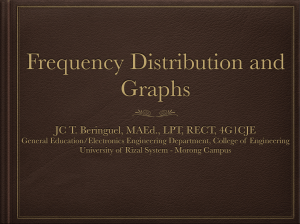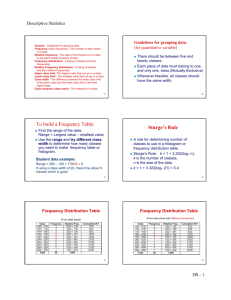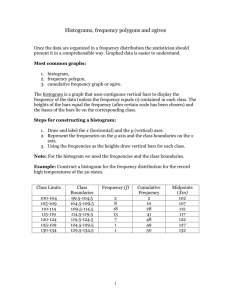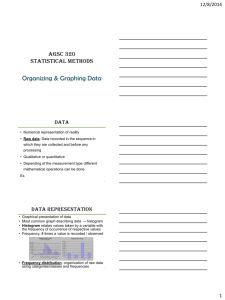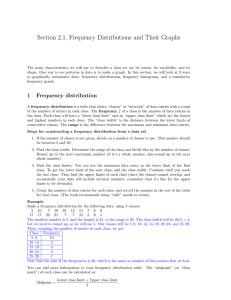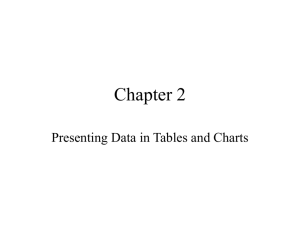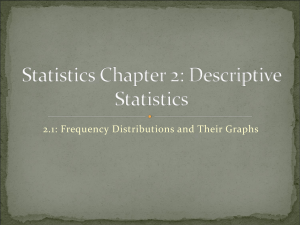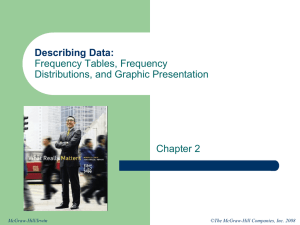Math 214 – Introductory Statistics Summer 2008 6-6
advertisement
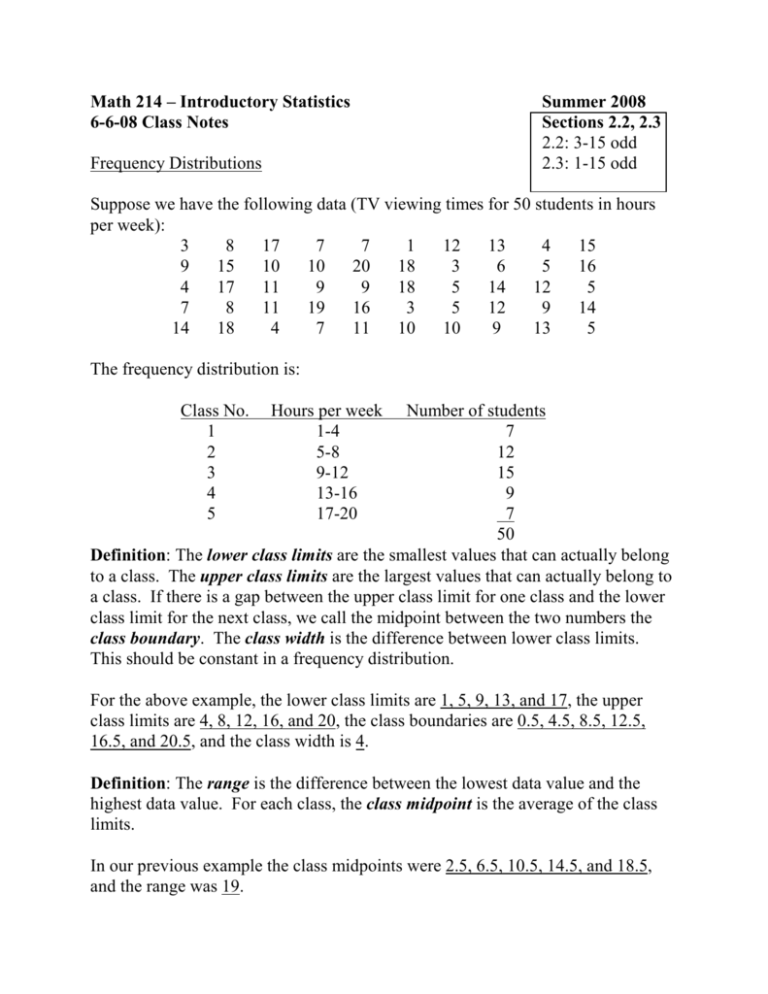
Math 214 – Introductory Statistics 6-6-08 Class Notes Frequency Distributions Summer 2008 Sections 2.2, 2.3 2.2: 3-15 odd 2.3: 1-15 odd Suppose we have the following data (TV viewing times for 50 students in hours per week): 3 8 17 7 7 1 12 13 4 15 9 15 10 10 20 18 3 6 5 16 4 17 11 9 9 18 5 14 12 5 7 8 11 19 16 3 5 12 9 14 14 18 4 7 11 10 10 9 13 5 The frequency distribution is: Class No. 1 2 3 4 5 Hours per week 1-4 5-8 9-12 13-16 17-20 Number of students 7 12 15 9 7 50 Definition: The lower class limits are the smallest values that can actually belong to a class. The upper class limits are the largest values that can actually belong to a class. If there is a gap between the upper class limit for one class and the lower class limit for the next class, we call the midpoint between the two numbers the class boundary. The class width is the difference between lower class limits. This should be constant in a frequency distribution. For the above example, the lower class limits are 1, 5, 9, 13, and 17, the upper class limits are 4, 8, 12, 16, and 20, the class boundaries are 0.5, 4.5, 8.5, 12.5, 16.5, and 20.5, and the class width is 4. Definition: The range is the difference between the lowest data value and the highest data value. For each class, the class midpoint is the average of the class limits. In our previous example the class midpoints were 2.5, 6.5, 10.5, 14.5, and 18.5, and the range was 19. Guidelines for constructing a frequency distribution: • Arrange your data in order from lowest to highest. • Decide on how many classes you want to have. There should be several, but not too many. Of course, this is an individual choice, but generally speaking, you should have 5 to 20 classes. Avoid empty classes (if possible). There is actually a formula to help make the decision as to how many classes to have, called Sturges’ Rule: # of classes ≈ 1 + 3.3log(n) (where n is the number of data values) • Choose your class width. It should be approximately equal to the range of data divided by the number of classes (if you don’t get an integer, round up!). Example: Construct a frequency distribution for the data below (which are grades on a Math 214 exam). 53 78 92 63 85 87 93 92 49 77 data 76 82 78 88 98 73 69 82 87 59 Class No. 1 2 3 4 5 6 62 65 89 94 93 53 69 78 87 93 sorted data 59 62 73 73 82 82 88 89 93 94 99 93 65 73 82 49 65 78 87 93 Grade 41-50 51-60 61-70 71-80 81-90 91-100 Number of students 1 2 5 6 8 8 30 63 76 82 92 98 65 77 85 92 99 A couple of properties of the classes: they must be exhaustive (every data value must fit somewhere) and mutually exclusive (every data value must fit in only one class). There are a few other columns we can have in a frequency distribution. In addition to the frequency for each class, we can have the cumulative frequency (the frequency of all classes up to an including the chosen class), the relative frequency (frequency of the class divided by the total number of data values), and the cumulative relative frequency (the relative frequency of all classes up to and including the chosen class). These are added below: Class 41-50 51-60 61-70 71-80 81-90 91-100 Freq. 1 2 5 6 8 8 30 Cum. Freq. 1 3 8 14 22 30 Rel. Freq. 1 ≈ .033 30 2 ≈ .067 30 5 ≈ .167 30 6 30 ≈ .200 8 ≈ .267 30 8 ≈ .267 30 1 Cum. Rel. Freq. .033 .100 .267 .467 .733 1.000 Graphical Representations Definition: A histogram is a bar graph where the horizontal axis represents the classes (specifically the class boundaries) and the vertical axis represents the frequencies or relative frequencies. Example: Let’s use the data from our last example and graph it. Definition: A frequency polygon is a piecewise linear graph for which the horizontal axis represents the class midpoints and the vertical axis represents the frequencies or relative frequencies. The ogive is a piecewise linear graph for which the horizontal axis represents the class upper limits and the vertical axis represents the cumulative frequencies or cumulative relative frequencies. The frequency polygon and the ogive for our data set are as follows: Finally, let’s draw all three graphs using the relative frequencies.

